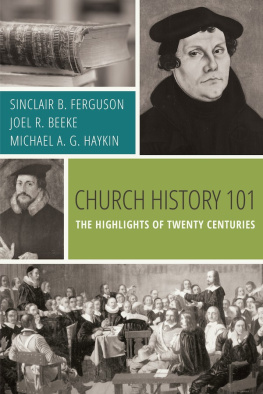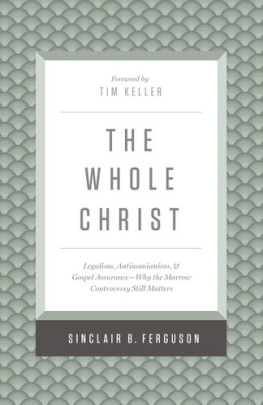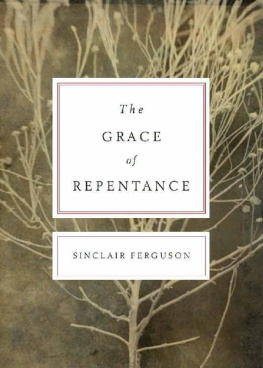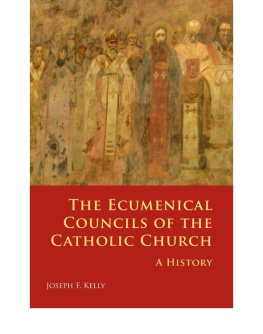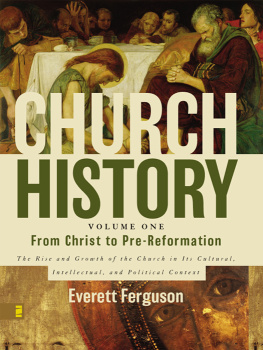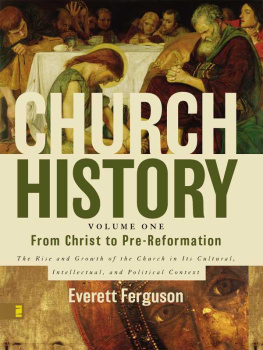Sinclair B. Ferguson - Church History 101: The Highlights of Twenty Centuries
Here you can read online Sinclair B. Ferguson - Church History 101: The Highlights of Twenty Centuries full text of the book (entire story) in english for free. Download pdf and epub, get meaning, cover and reviews about this ebook. year: 2016, publisher: Reformation Heritage Books, genre: Religion. Description of the work, (preface) as well as reviews are available. Best literature library LitArk.com created for fans of good reading and offers a wide selection of genres:
Romance novel
Science fiction
Adventure
Detective
Science
History
Home and family
Prose
Art
Politics
Computer
Non-fiction
Religion
Business
Children
Humor
Choose a favorite category and find really read worthwhile books. Enjoy immersion in the world of imagination, feel the emotions of the characters or learn something new for yourself, make an fascinating discovery.
- Book:Church History 101: The Highlights of Twenty Centuries
- Author:
- Publisher:Reformation Heritage Books
- Genre:
- Year:2016
- Rating:3 / 5
- Favourites:Add to favourites
- Your mark:
- 60
- 1
- 2
- 3
- 4
- 5
Church History 101: The Highlights of Twenty Centuries: summary, description and annotation
We offer to read an annotation, description, summary or preface (depends on what the author of the book "Church History 101: The Highlights of Twenty Centuries" wrote himself). If you haven't found the necessary information about the book — write in the comments, we will try to find it.
Church History 101: The Highlights of Twenty Centuries — read online for free the complete book (whole text) full work
Below is the text of the book, divided by pages. System saving the place of the last page read, allows you to conveniently read the book "Church History 101: The Highlights of Twenty Centuries" online for free, without having to search again every time where you left off. Put a bookmark, and you can go to the page where you finished reading at any time.
Font size:
Interval:
Bookmark:
TENTH CENTURY

The Dark Ages
We sometimes say that history repeats itself. At the end of the first millennium, the situation of the church was much the same as we face today. In the tenth century, the church was in decline theologically though not culturally and politically. We call this period the Dark Ages, and in some ways, the description is accurate. Once-strong empires and kingdoms were beginning to crumble. The balance of power was shifting toward the church and territorial boundaries were shifting as well.
Another similarity is the nominal Christianity of the tenth century. Part of this nominalism resulted from the struggle for power and influence outside the church, which led to neglect of cultivating faith on the inside. The power gains of the church tended to corrupt the church and her leaders. Educational standards fell, and many of those who ministered Gods Word were altogether ignorant of it. An ignorant ministry could not arrest the inherent decay in society with the power of the gospel. New political powers from the north (the Vikings or Norsemen) and the south and east (Muslims) swept in, challenging the worldly power of the church. The church responded with little to no spiritual direction for its members.
One exception came from a group of monastics at Cluny in eastern France. These Benedictine monks, seeing the spiritual decline all around, devoted themselves to the study of Scripture, the worship of God, simplicity of Christian living, and various other spiritual disciplines. They recognized that by and large, the members of the church had lost their zeal to know the Lord and live in devotion to Him. Leaders of the church had become worldly-minded and disinterested in spiritual matters. The Cluniac reform began as one of the more spiritual efforts of the Middle Ages, but the movement would itself suffer decay and yield to temptations to worldliness, requiring yet another reform in the following centuries.
In the last years of the tenth century, Christianity extended its reach into Russia with the baptism of Prince Vladimir and his twelve sons at Kiev in 988. Vladimir embraced Christianity upon receiving the reports of envoys sent to Constantinople. They gave a positive account of the faith and worship of that great city, and were impressed by the splendor of Justinians Holy Wisdom Basilica. The pioneering work of Cyril and Methodius among the southern Slavs had prepared the way by furnishing a liturgy and a body of Christian literature in Slavonic. Most of the people of Kiev followed their princes example, and thousands were baptized in the Dnieper River. From such beginnings sprang the Russian Orthodox Church.
The close of the first millennium of the Christian era found the church in a position of cultural dominance, at least within the boundaries of the Roman Empire. The church also had had no small measure of success in surviving barbarian invasions and converting the invaders.
As the empire was divided and began to retreat in the face of the invading barbarians, the church was likewise divided, East and West. The Eastern church lived under the protection of the Roman emperors, who now reigned in Constantinople. She enjoyed imperial patronage, but also suffered much from imperial interference in her affairs. The Western church had to stand alone, filling the vacuum left behind as the seat of empire shifted to the East. The popes of Rome were in a position to take power into their own hands, and they did so, with no one to call them to account. Large parts of Italy were ruled by the popes, who owned huge tracts of land, using the revenues of those lands to fund their campaigns to dominate both the world-wide church and the rulers of the many kingdoms and principalities under their sway.
Todays world is not much different from that of the tenth century. The church continues to be confronted with paganism, as well as with temptations to worldly success. While some denounce the tenth century as the Dark Ages, we must recognize that our contemporary society demonstrates a moral and spiritual darkness, and the church is challenged to respond with the light of the gospel. Sometimes the church stands by and lets her witness be muted by worldly concerns. Rather, the church should perpetually increase in the knowledge of Gods Word, be strengthened by the worship of God, and give itself to the simplicities of day-by-day devotion to Jesus Christ. By living for Christ and proclaiming the gospel, we can shine a much-needed light in the darkness.
ELEVENTH CENTURY

The Great Schism; Anselm of Canterbury
The eleventh century still found the church in a dark place, though glimmers of light continued to shine through. One of its darkest events, usually referred to as the Great Schism, took place in 1054. The de facto division between the Latin-speaking Western church and the Greek-speaking churches of the East was made absolute and irreconcilable. The pope of Rome and the patriarch of Constantinople excommunicated each other, and the bodies of churches under the authority of each were arrayed against each other as hostile camps. The unity of the visible church was broken, and remains broken down to our time.
The disagreement centered on the addition of the filioque (that is, and from the Son) clause to the Nicene Creed. In the fifth century, Western scholars, under the influence of Augustine, had begun to look afresh at the Scriptures regarding the relationship of the Spirit to the Father and the Son. They came to the conclusion that the Scriptures teach that the Holy Spirit proceeds not only from the Father, but also from the Son. Therefore, from the fifth century onward, the Western Church had added the filioque clause to the relevant article of the Nicene Creed, giving it the form in which it has come down to us today: I believe in the Holy Ghost, the Lord and Giver of life; who proceedeth from the Father and the Son.
The Eastern churches took issue and appealed to the original formulation of the Council of Nicaea, arguing that the Latin-speaking Western church did not have authority to alter a formula adopted by an ecumenical council. But behind this concern was the objection of the Eastern churches to the Western claim that the pope was the supreme bishop of the worldwide church and the vicar or representative of Jesus Christ on earth.
One glimmer of light during this dark time was Anselm of Canterbury, a gifted intellectual and a man of considerable spiritual and moral courage. Anselm promoted his famous ontological argument for the existence of God and served the church by providing thoughtful theological argumentation and philosophical analysis regarding the existence and nature of God.
Anselms Cur Deus Homo , or Why Did God Become Man? plumbed the depths of the atonement of Jesus Christ and the purposes of God that stood behind it. He argued that Gods justice requires Him to punish sins committed against His infinite majesty with everlasting punishment of the sinner, in body and soul. As sinners, our only hope is to find a mediator and deliverer who is very man and perfectly righteous, and therefore able to satisfy for our sins; but also very God, more powerful than all creatures, and therefore able to sustain the burden of Gods wrath and obtain righteousness and eternal life for us. Our Lord Jesus Christ, who is very God and very man, is the Savior God has provided for us.
During this time, many within the church recognized the corruption bred by the close relationship between church and state. From the time of Constantine, kings had claimed the right to appoint bishops for the churches under their rule, and they naturally chose men who favored their policies and helped them curry favor with the people. Beginning in the eleventh century, a series of popes began to challenge the authority of monarchs in this practice. The conflict became known as the Investiture Controversy, so named because the kings who appointed the bishops invested them with titles, possessions, and other temporal rights, as well as the symbols of their office, including a gold staff, or crosier, and a gold ring. Pope Gregory VII responded by asserting the power of the church to elect bishops and translate them (move them from one see to another). The pope also asserted his power over the Holy Roman emperor, citing the coronation of Charlemagne in the ninth century as a precedent. The conflict would continue into the twelfth century, finally ending with the pope securing most of the power for which he and his predecessors had contended.
Next pageFont size:
Interval:
Bookmark:
Similar books «Church History 101: The Highlights of Twenty Centuries»
Look at similar books to Church History 101: The Highlights of Twenty Centuries. We have selected literature similar in name and meaning in the hope of providing readers with more options to find new, interesting, not yet read works.
Discussion, reviews of the book Church History 101: The Highlights of Twenty Centuries and just readers' own opinions. Leave your comments, write what you think about the work, its meaning or the main characters. Specify what exactly you liked and what you didn't like, and why you think so.

